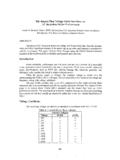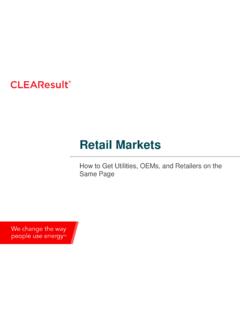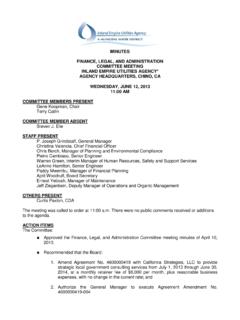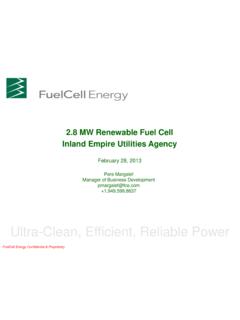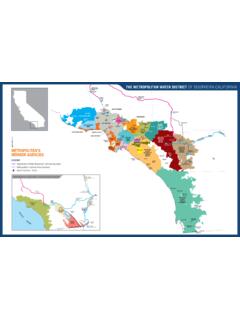Transcription of Inland Empire Utilities Agency’s (IEUA) Water-Energy Nexus ...
1 1 IEUA s LEED Platinum HeadquartersInland Empire Utilities agency s (IEUA) Water-Energy Nexus : Combining Energy Efficiency and Water EfficiencyPresented by:Eliza Jane WhitmanDeputy Manager, Engineering Inland Empire Utilities agency (IEUA)ACEEE 3rdNational Conference on Energy Efficiency as a ResourceLocation map23 Regional wholesale distributed water and wastewater treatment for 7 cities, two water districts, and two water companies Imported water supply distribution Four regional wastewater treatment plants Two non-reclaimable wastewater sewer pipeline systems One reverse osmosis desalination plant (joint power authority) Biosolids and organics management, the State s first completely-enclosed composting facility (under construction) Recycled water program Water conservation program Serve 242 square miles of drought challenged Chino Basin Desert climate zone of So. CA averages 13 rainfall per year High urban growth (part of Santa Ana River Watershed) Annual population growth between 1990 and 2000 > 3% per year Population 780,000 projected to grow to million by 2025 Conversion of agricultural lands to urban use will increase municipal and industrial demand for waterIEUA Profile.
2 Municipal Water District4 Water Demand/Supply Balance Projections[1] 2000 Urban Water Management Plan, Preliminary Data for 2005 Urban Water Management Plan 1990 2005 2025 Population 515,100 788,000 1,050,000 Water Demand 206,100 AF 221,000 AF 330,000 AF Groundwater 180,000 182,800 AF 188,000 AF Desalter 7,000 AF 25,000 AF Imported Water 32,083 AF 75,000 AF 70,000 AF Surface Water 15,000 13,500 AF 13,500 AF Recycled Water n/a 5,600 AF 45,000 AF Projected Conservation n/a 5,000 AF 33,000 AF 35 IEUA s Service Area is within the Chino Basin6 Energy is a significant component of the cost of IEUA s water supplies (ranges from 400 to 3,200 kW per AF) The 2000/01 California Power Crisis created significant risks, both to public health & safety, and to water ratepayers IEUA responded by adopting a policy of energy self-sufficiency IEUA received Flex Your Power award for energy reduction programs IEUA re-evaluated water supply options in light of energy requirementsIEUA s Water+Energy Nexus474009501,0501,7002,0002,5003,2004, 400-5001,0001,5002,0002,5003,0003,5004,0 004,500 KWH/AFRecyclingGroundwaterPumpingIon ExchangeChinoDesalterColoradoRiverAquedu ctWest BranchState ProjectWaterEast BranchState ProjectWaterOceanDesalterEnergy Use by SourceThe Energy Intensity of IEUA s Water SuppliesWater Assets of the Chino Basin Groundwater 5-7 Million Acre-feet of Storage one of the largest groundwater basins in southern California 1 million acre-feet of unused storage capacity currently Safe Yield of 140.
3 000+ Acre-feet per year with capacity to increase Over 800 Active Wells High Quality Recycled Water Over 90,000 Acre-feet of water available for reuse Storm Water Capture Region now loses over 50,000 acre-feet per year on average of water that historically recharged the Chino Groundwater Basin Opportunities for Water Efficiency Over 60% of water use within region is for outdoor irrigation5 Precipitation and Run Off in the Chino Basin over seventy 2-6 Storm Water Discharge Time History for the Santa Ana River Below Prado Dam050,000100,000150,000200,000250,00030 0,000350,000400,000450,000500,0001920192 1192219231924192519261927192819291930193 1193219331934193519361937193819391940194 1194219431944194519461947194819491950195 1195219531954195519561957195819591960196 1196219631964196519661967197019711972197 3197419751976197719781979198019811982198 3198419851986198719881989199019911992199 3199419951996199719981999 Annual Storm Water Discharge (acre-ft/yr)-30-20-10010203040506070 Cumulative Departure from Mean Precipitation (in/yr)
4 Annual Storm Water DischargeCum Dep from Mean Precip10 Integrated Water Resources Program$350 Million in Capital Projects Chino I/II Desalters 25,000 AF/Yr yield $68 Million Recharge Master Plan 23,000 AF/Yr Storm water 20 - 40 AF/Yr Recycled Water 80 - 120,000 AF/Yr Imported Water $40 $50 million MWD Conjunctive Use 100,000 AF, 33,000 AF/yr yield $ million Recycled Water 90,000 AF/Yr $200 million Conservation 25,000 AF/Yr $10 million611 Projected Chino Basin Imported Water Demands025,00050,00075,000100,000125,000 150,000175,00019952000200520102015202020 25 Fiscal YearAcre-Feet per YearImported Water Demand with New Regional and Local ProjectsImported Water Demand with New Regional and Local Projects during Drought YearsImported Water Demand without New Regional and Local Projects Without the Integrated Water Management Strategy, the need for expensive imported water is expected to increase from 60,000 acre-feet to over 150,000 acre-feet With the implementation of the planned water initiatives, the region will significantly reduce it need for imported water and during dry years almost completely roll off imported water supplies12 Peak Electric Demand currently 9 MW Projected to grow to 25 MW in 2010 Self Generation Capacity MW cogeneration Purchase 200 mcf natural gas for self generation Produce 225,000 cfd digester gas from Dairy Manure digester that is piped miles to the Chino Desalter for self generation Current Net Energy Requirements 2 MWNote: IEUA Platinum Headquarters will be 100% energy self sufficientin 2006.
5 Building design and photovoltaic installed on the roof reduced energy requirements to the equivalent of 2 residencesIEUA s Energy Requirements713 65 mgd tertiary wastewater treatment Wastewater treatment consumption 52% Primary/Secondary 20% Solids handling 28% Tertiary treatment/Disinfection 9 mgd groundwater pumping and desalination (will increase to 25 mgd) Imported & recycled water distributionPrimary Uses of Energy14 Projected Electric Loads20102002201020022010200220,3803,611 1,1001,9716,3198196,5608,89601,3201,4261 ,5507503,850 Peak Demand (kW)2,3651,1887104289 mgdDesalter24,456[2]6,9407,3372,485 Totals4,33300015 mgdRP#51,3201, mgdRP#47,5831,1502, mgdCarbon Canyon98350029528330 mgdRP#27,8722,9922,3621,07738 mgdRP#1 Avg Demand (kW)Safety Demand[1] (kW)Capacity (mgd)[1] Minimal loads essential for health & safety, estimated at 30% of peak demand.[2] 115% increase in energy requirements from 2002 to 2010 attributable to population growth (increased volume of wastewater treatment) and increased recycled water pumping.
6 Peak demand projected to increase an additional 30% by dgas/ngas300,000 cfd1,000 kW1,200 kW9 mgdDesalterDgas/mgas/ngas1,400 kcfd5,850 kW8,950 kW81 mgdTotalsIn-service 20061,500 kW15 mgdRP#5100% ngasn/a650 kW1,150 mgdRP#4100% ngasn/a950 kW1,200 mgdCarbon Canyon70/30 dgas/ngas200,000 cfd500 kW500 kW30 mgdRP#270/30 dgas/ngas900,000 cfd2,800 kW3,400 kW38 mgdRP#1 Fuel for CogenerationDigester GasSelf Generation[1]Electric LoadCapacity[1] Does not include diesel generatorsTreatment Facilities Energy Profile16 IEUA Energy/Water Strategies Incorporate energy efficient best practices into all aspects of IEUA sfacilities and system design and operations LEED Headquarters Lighting Efficiency Pump Efficiencies Energy By Design Projects Incorporate Energy Efficiency into Project Design Standards917 IEUA Energy/Water Strategies Reduce dependence on high energy intensity water supplies Develop and implement end use water conservation programs Develop recycled and local groundwater supplies Work with local developers and other agencies to incorporate sustainability design principles ( , water efficient landscapes, water and energy efficient appliances)
7 Into new developments18 IEUA Energy/Water StrategiesShift all possible peak loads to partial and off-peak periods Incorporate process flexibility into system design to facilitate load shifting ( , storage and pipelines that allow detention of flows during peak periods) Turn off schedulable processes during peak periods1019 IEUA Energy/Water StrategiesMaximize digester gas production and use Increase energy content of bio-feedstock in digesters Integrated into organics management program for community Maximize value of excess methane generation through net metering Air quality credits generate additional value (and revenue) Added value of high quality soil nutrient Water quality, other community benefits20 IEUA Energy/Water Strategies Develop other local energy resources Install other methane gas generation technologies (gasification) Capture energy value of falling water (hyrdo in pipelines and outfalls) Use solar power technology (pv potential for recycled water pump stations, wastewater treatment plant processes)1122 Contact:Eliza Jane WhitmanDeputy Manager, EngineeringInland Empire Utilities Agency6075 Kimball AvenueChino, CA 91710 Direct Line: (909) more information.
8



